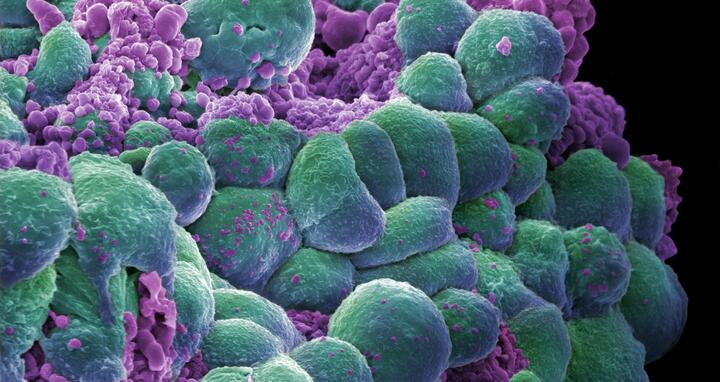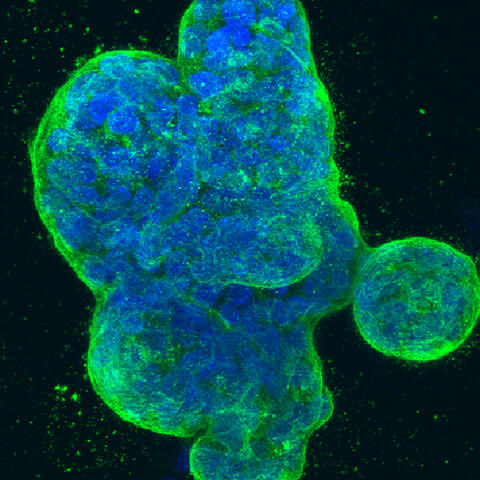Keeping aggressive cancer cells in check
Every cell has two different “tools” for repairing DNA single- or double-strand breaks, which can be induced by such factors as environmental toxins, chemotherapy, or ionizing radiation. The first one consists of the DNA repair genes BRCA1 and BRCA2, while the second one is an enzyme called poly-(ADP-ribose) polymerase, or PARP1 for short. These tools are used by both healthy and malignant cells. They ultimately do the same thing and can substitute for each other. If DNA repair fails because the damage is too extensive, the cell initiates its suicide program – apoptosis – and destroys itself. This process has become a target for cancer treatments.
People who carry BRCA1 and/or BRCA2 gene mutations have a very high risk of developing certain types of tumors, most notably breast, ovarian, and prostate cancer. These individuals lack one of these tools, which explains why they are more prone to develop cancerous cells. Such tumor cells also have only one tool at their disposal – PARP1 – to ensure their survival. Yet BRCA1/2-associated tumors are typically very aggressive and difficult to treat. So researchers led by Prof. Claus Scheidereit of the Max Delbrück Center, the last author of the study, took a close look at the signaling pathway that activates the PARP1 enzyme. In the process, they discovered a way to target and render this tool useless.
To prevent apoptosis after DNA damage, a key signaling pathway called NF-κB kicks in. It initiates the transcription of genes in the cell nucleus that ultimately activate PARP1 so that the cell can repair the damage. By switching off genes one by one, Ahmet Tufan, co-first author of the study along with Katina Lazarow of the Leibniz-Forschungsinstitut für Molekulare Pharmakologie (FMP), screened the entire human genome for genes that regulate this signaling pathway. To do this, he first introduced a “measurement gene” into the genome, which provides the blueprint for a fluorescent protein tag. “A few hours after treatment with the chemotherapeutic agent etoposide has induced DNA damage, the cells light up green because NF-κB is activated,” Tufan explains. A great, great many of the samples for the 20,000 genes lit up – but some did not. This was because in these samples a gene that plays an important role in the signaling pathway was apparently switched off.
Hindering PARP1 repairs
Three-dimensional culture of human breast cancer cells, with DNA stained blue and a protein in the cell surface membrane stained green.
This image was originally submitted as part of the 2015 NCI Cancer Close Up project and selected for exhibit. See also visualsonline.cancer.gov/closeup.
But which one? The number of candidate genes was in the thousands – after all, the NF-κB signaling pathway controls a wide range of cell functions, such as immune response. “We used bioinformatics to eliminate those that performed routine “housekeeping” tasks in the cell, then subjected the remaining 500 genes to the same procedure once more.” The team again used etoposide to induce DNA damage. “For each gene, we ran parallel tests using the cytokine TNF-alpha, which also activates this signaling pathway but only comes into play when there is inflammation,” says Scheidereit.
After this, only a small group of genes remained. The researchers already knew that some of them were part of the signaling pathway, but not others. Which was the crucial one? Tufan used algorithms to search various databases for clues. Where were products of these genes mentioned alongside others? Were there any papers out there claiming that the proteins in question join with others to form complexes? The team also combed through the lab’s own databases. Then, suddenly, they found what they were looking for: tumor susceptibility gene 101 (TSG101). This gene was not a new discovery in itself; it plays many known roles in the cell. But in this particular process, it binds to PARP1 as soon as the enzyme has docked at the site of damage. Then and only then can PARP1 itself become active.
“PARP1 is like a loaded gun,” says Scheidereit. “Whether you merely scratch the cells, apply shear stress to them, or smash them up completely, PARP1 is activated. But if there’s no TSG101 in the cell, it doesn’t work. It’s missing the trigger, so to speak.” The researchers were able to watch what was happening live under the microscope using fluorescent-stained PARP1. A few seconds after they had burned tiny holes in the cell nucleus with a laser, the cells lit up green as PARP1 poured into the cell nucleus from all sides and bound to the sites of DNA damage. After a few minutes, the glow dimmed.
An astonishing observation
However, based on our results, a targeted search can now begin for therapeutic agents that block the binding of TSG101 to PARP1.
“PARP1 modifies itself, attracts other helper proteins that carry out the necessary repairs, and then detaches itself,” Scheidereit explains. If the TSG101 gene was switched off, however, PARP1 flowed into the sites of DNA damage in the cell nucleus just as quickly – but the green glow remained. PARP1 was not able to break free from the damaged DNA. “Of all the observations I made during the live-cell imaging experiments, this was the most astonishing,” says Tufan. “In TSG101-free cells, PARP1 actually became trapped at the sites of DNA damage.”
“With this research, we have shown that administering PARP inhibitors and switching off of TSG101 have the same effect,” summarizes Scheidereit. Using various breast cancer cell lines, the researchers were also able to show in the lab that cells without the TSG101 gene died quickly after chemo. However, the cells that perished the fastest were those with BRCA1 mutations, as they no longer had any tools for DNA repair.
PARP inhibitors have already been used for several years in the treatment of certain cancers – for example, in therapies for breast cancer patients with a proven BRCA mutation. “Unfortunately, no single inhibitor has yet been developed that specifically targets PARP1, as there is a whole group of PARP genes,” says Scheidereit. “However, based on our results, a targeted search can now begin for therapeutic agents that block the binding of TSG101 to PARP1.” The study may therefore pave the way for the future development of highly effective and more targeted therapies for BRCA1/2-associated cancers.
Text: Catarina Pietschmann
Further informationen
Literature
Ahmet Buğra Tufan et al. (2022): „TSG101 Associates with PARP1 and is Essential for PARylation and DNA Damage-induced NF-κB Activation“. EMBO Journal, DOI: 10.15252/embj.2021110372
Contacts
Prof. Claus Scheidereit
Max Delbrück Center for Molecular Medicine in the Helmholtz Association (MDC)
+49-(0)30-9406-3816
scheidereit@mdc-berlin.de
Christina Anders
Editor, Communications Department
Max Delbrück Center for Molecular Medicine in the Helmholtz Association (MDC)
+49-(0)30-9406-2118
christina.anders@mdc-berlin.de or presse@mdc-berlin.de
- Max Delbrück Center
-
The Max Delbrück Center for Molecular Medicine in the Helmholtz Association (Max Delbrück Center) is one of the world’s leading biomedical research institutions. Max Delbrück, a Berlin native, was a Nobel laureate and one of the founders of molecular biology. At the locations in Berlin-Buch and Mitte, researchers from some 70 countries study human biology – investigating the foundations of life from its most elementary building blocks to systems-wide mechanisms. By understanding what regulates or disrupts the dynamic equilibrium of a cell, an organ, or the entire body, we can prevent diseases, diagnose them earlier, and stop their progression with tailored therapies. Patients should be able to benefit as soon as possible from basic research discoveries. This is why the Max Delbrück Center supports spin-off creation and participates in collaborative networks. It works in close partnership with Charité – Universitätsmedizin Berlin in the jointly-run Experimental and Clinical Research Center (ECRC), the Berlin Institute of Health (BIH) at Charité, and the German Center for Cardiovascular Research (DZHK). Founded in 1992, the Max Delbrück Center today employs 1,800 people and is 90 percent funded by the German federal government and 10 percent by the State of Berlin.






